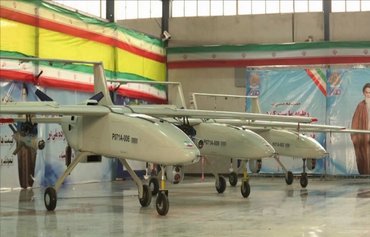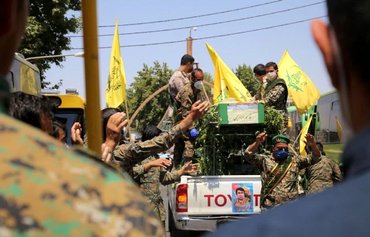Lebanese Hizbullah specialists have been training members of the Afghan-comprised Fatemiyoun militia on operating drones in the Syrian Badiya (eastern desert), near Palmyra, observers say.
Hizbullah specialists were present at the al-Talila site near Palmyra to train Fatemiyoun Division members and carried out exercises after teaching them about drones, said media activist Ammar Saleh.
Hizbullah personnel have trained the elements on aircraft maintenance in hideouts created and formerly used by the "Islamic State of Iraq and Syria" (ISIS), he said.
The area in the Badiya region where the exercises took place was completely cordoned off at the time, and Syrian elements were prohibited from entering it, according to Saleh.
![Elements of the IRGC-backed Afghan Fatemiyoun militia attend a religious ceremony on July 19. [Fatemiyoun Telegram channel]](/cnmi_di/images/2022/08/23/36787-fatemeyioun_pic_3-600_384.jpg)
Elements of the IRGC-backed Afghan Fatemiyoun militia attend a religious ceremony on July 19. [Fatemiyoun Telegram channel]
![IRGC-backed Fatemiyoun militia elements are shown in the Syrian Badiya (eastern desert) near Palmyra in 2017. [Tasnim News]](/cnmi_di/images/2022/08/23/36788-fatemeyioun_pic_2-600_384.jpg)
IRGC-backed Fatemiyoun militia elements are shown in the Syrian Badiya (eastern desert) near Palmyra in 2017. [Tasnim News]
The training included teaching Fatemiyoun members to use the Ababil-3 drone and a smaller aircraft of an unknown model.
Iran-backed militias are trained in the Badiya region on a regular basis, causing livestock breeders and shepherds to flee the region in fear, Saleh said.
This intimidation, he noted, has altered the social and demographic landscape of the area, which is historically home to various tribes.
Hizbullah, Fatemiyoun expanding presence
The relationship between Hizbullah and the Fatemiyoun militia is very close, said Sheyar Turko, an analyst who focuses on militias affiliated with the Islamic Revolutionary Guard Corps (IRGC).
"The party has previously brought in specialists to train Fatemiyoun elements on sniper operations, artillery shelling and the formation of special forces," he said.
The co-operation between Hizbullah and Fatemiyoun began in 2016 when the presence of the Afghan militia first became known in Syria, he said.
"The exclusive control these two groups have over Badiya raises many questions about the exclusion of other pro-IRGC militias, especially Syrians, from the region."
Hizbullah's influence in the Palmyra area has greatly expanded in light of Russian forces' withdrawal, Turko said. Now, Hizbullah and Fatemiyoun have the entire area under their control, have expanded their recruitment efforts, and have dozens of weapon depots and underground hideouts.
Hizbullah has the largest weapons depots in the Badiya region, with a very large arsenal of missiles and equipment for producing rockets and other weaponry, he added.
Syrian lawyer Bashir al-Bassam challenged the use of drones by IRGC-affiliated militias in Syria, adding that this practice "puts Syria and Syrians in a more difficult position".
"The question is, why equip these militia groups with drones?" he said.
The Iranian regime justifies the presence of its militia and its deployment of drones by citing alleged terrorist threats on the ground in Syria, but this is a false pretext, as no real terrorist threats exist on the ground, said al-Bassam.
Instead, he said, Iran's actions will expose Syria to additional international sanctions, as the IRGC's presence in the country and its use of drones create tensions.
The Hizbullah-Fatemiyoun actions in Syria are reminiscent of the Iran-backed Houthis' attacks launched on Saudi Arabia and the United Arab Emirates (UAE) using Iranian missiles and drones.

![Lebanese Hizbullah specialists have trained the Afghan-comprised Fatemiyoun Division militia on operating the Ababil-3 drone, shown here in 2014. [Tasnim News]](/cnmi_di/images/2022/08/23/36786-drone_pic_1-600_384.jpg)






